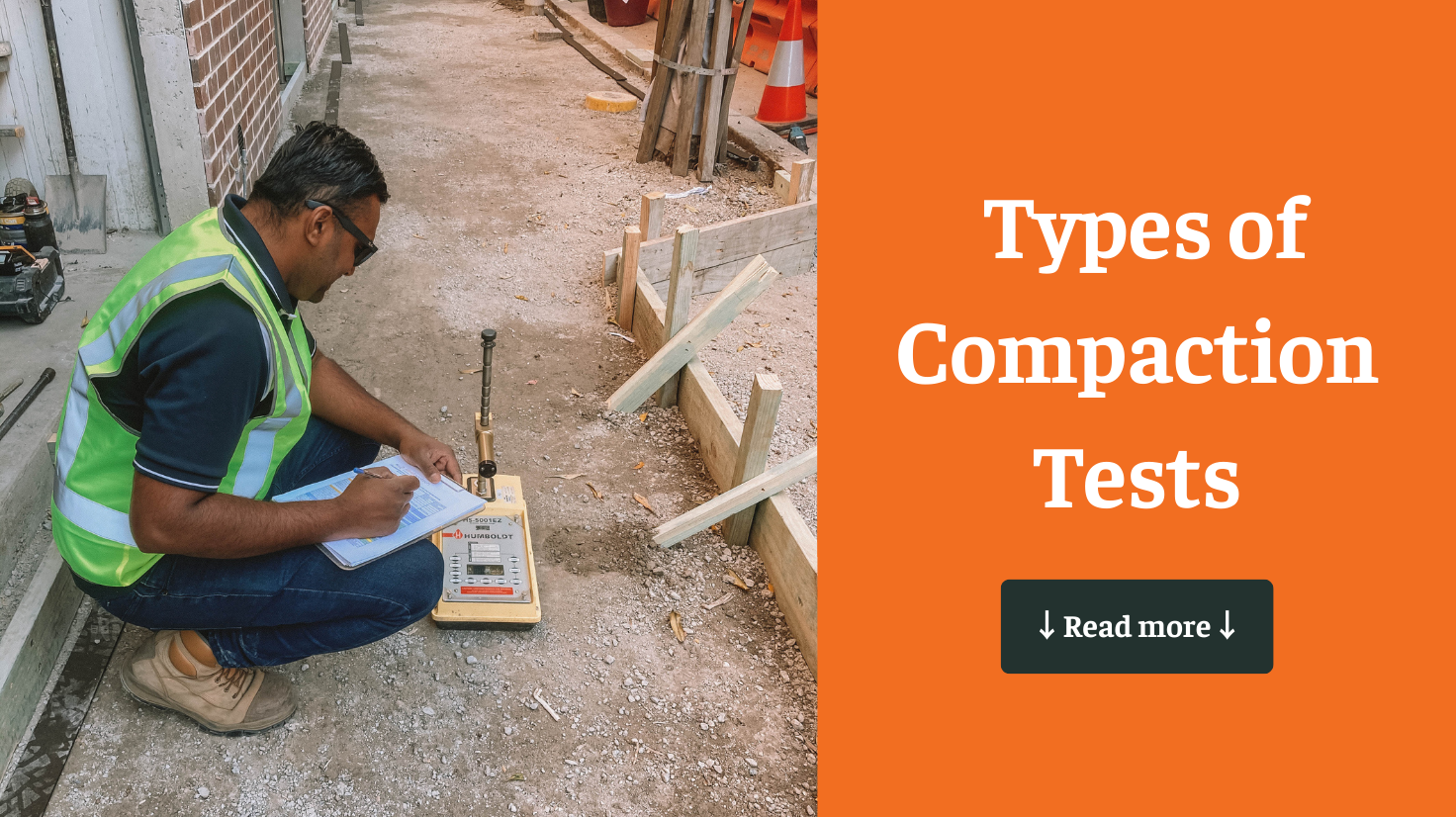Compaction testing is an essential part of geotechnical engineering, used to assess the strength and stability of soil in construction projects. There are various types of compaction tests in geotechnical engineering, depending on whether the tests are conducted in the field or a laboratory. Each method is designed to measure soil density, moisture content, and how well the soil can support the loads imposed on it by buildings, roads, or other structures. Below is a detailed look at the most common types of compaction tests in geotechnical engineering used in construction.
1. Standard Proctor Test
The Standard Proctor Test is one of the most widely used methods to evaluate the compaction characteristics of soil. This test measures the maximum dry density and optimum moisture content that the soil can achieve under standardised compaction efforts. The process involves compacting the soil into a cylindrical mould in layers. Each layer is compacted by dropping a standard hammer from a specified height.
The key purpose of the Standard Proctor Test is to determine the moisture level at which soil can achieve its maximum density under standard compaction. It’s especially useful for lighter construction projects, such as residential developments or smaller roads, where soil loads are relatively moderate.
Procedure:
- Soil is compacted into a mould in several layers.
- A hammer of known weight is dropped from a fixed height to compact each layer.
- The dry density of the soil is measured at different moisture contents to find the optimum moisture level.
Application:
This test is commonly used in site preparation to ensure that the soil is adequately compacted before construction begins. It is also employed in residential and commercial construction where soil conditions are moderate.
2. Modified Proctor Test
The Modified Proctor Test is a more advanced version of the Standard Proctor Test, designed for situations where soil needs to support much heavier loads. The main difference lies in the amount of compaction energy applied: the Modified Proctor Test uses a heavier hammer and applies more force to the soil. This test is particularly useful for projects like highways, airport runways, and large commercial developments, where the ground needs to support significant weight and heavy traffic loads.
Procedure:
- Similar to the Standard Proctor Test, soil is compacted in a mould in layers.
- A heavier hammer is used, and it is dropped from a greater height to apply more energy to the soil.
- The results provide the maximum dry density and optimum moisture content at higher compaction efforts.
Application:
This test is typically used for high-stress infrastructure projects such as highways, airport runways, or large industrial complexes where soils must withstand higher loads.
3. Field Density Test (Sand Cone Method)
The Field Density Test, often referred to as the Sand Cone Method, is one of the most common methods for determining the density of compacted soil in the field. This method is used after soil has been compacted on-site to confirm that it meets the required specifications.
The test involves digging a small hole in the compacted soil, weighing the excavated soil, and then filling the hole with calibrated sand. The volume of the sand used is then measured, and the weight and volume of the excavated soil are compared to calculate the soil’s in-place density.
Procedure:
- A hole is dug in the compacted soil, and the removed soil is weighed.
- The hole is filled with calibrated sand, and the volume of sand used is recorded.
- The weight of the removed soil is compared to the volume of sand to determine the soil’s density.
Application:
This test is particularly useful in road construction, embankments, and other large-scale earthwork projects. It provides an accurate measurement of field compaction and ensures that the soil meets the necessary compaction standards.
4. Nuclear Density Test
The Nuclear Density Test is a modern and highly accurate method of measuring soil density and moisture content in the field. This test uses a device that emits gamma radiation into the soil to measure its density and moisture content. It’s a quick, non-invasive method that delivers real-time results, making it a preferred option for large projects where immediate feedback is required.
Procedure:
- A nuclear gauge is placed on the soil surface or slightly embedded into the ground.
- The device emits gamma rays into the soil, which are absorbed at different rates depending on the soil’s density and moisture content.
- The reflected gamma rays are measured, and the device calculates the soil’s density and moisture level.
Application:
This test is ideal for large-scale infrastructure projects like highways, railways, and airport construction, where quick and accurate results are needed. Its non-destructive nature means that compaction tests can be performed frequently and efficiently without disturbing the site.
5. Plate Load Test
The Plate Load Test is primarily used to determine the bearing capacity and settlement characteristics of soil. This test is commonly employed in field conditions to assess how much settlement occurs under applied loads. A steel plate is placed on the compacted soil, and a load is gradually applied. Engineers then measure the amount of settlement that occurs under the load to determine whether the soil is capable of supporting the intended structure.
Procedure:
- A steel plate is placed on the compacted soil.
- A load is applied incrementally to the plate.
- The settlement of the soil under each load is measured and recorded.
- Based on the results, the bearing capacity and settlement behaviour of the soil are assessed.
Application:
This test is useful for foundation design, particularly in large structures where soil settlement must be carefully evaluated. It’s commonly used in bridge construction, high-rise buildings, and other projects requiring in-depth soil analysis.
6. Conclusion
Each type of compaction test in geotechnical engineering serves a specific purpose, whether it’s assessing soil conditions for small residential projects or determining the bearing capacity of soil for large infrastructure developments. Types of compaction tests in geotechnical engineering, such as the Standard Proctor Test and Modified Proctor Test, are valuable for determining the optimum moisture content and density of soil. Field-based tests like the Sand Cone Method and Nuclear Density Test provide real-time data on soil compaction at construction sites. The Plate Load Test, on the other hand, evaluates the soil’s ability to support heavy loads.
By choosing the right types of compaction tests in geotechnical engineering, engineers can ensure that the soil provides a stable foundation, minimising the risk of settlement, shifting, or failure in any construction project.
Order Our Geotechnical Services Now







